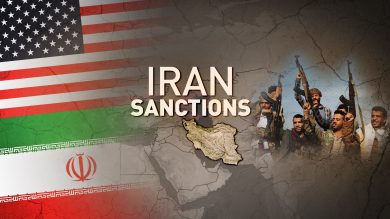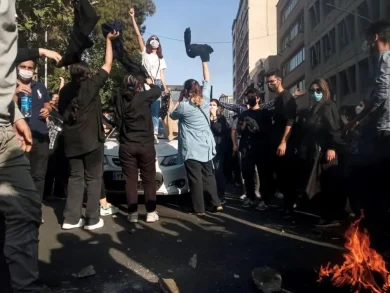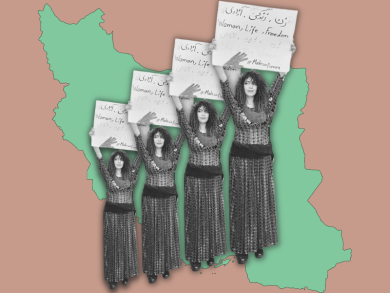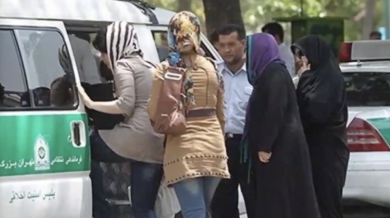For decades, Iranian women have been at the forefront of resistance against oppression, discrimination, and tyranny. From the streets to prisons, from digital activism to underground networks, women have consistently challenged the Islamic Republic’s patriarchal laws and the brutality of the IRGC. Their relentless courage, despite state violence, arrests, and censorship, proves that women are not just part of the movement—they are leading it.
The “Women, Life, Freedom” movement is more than a slogan—it is a declaration of Iran’s democratic future. As Iranian women continue to defy the mandatory hijab, fight for political change, and organize protests, it is clear that they are the key to Iran’s liberation.
This article explores:
• How Iranian women’s resistance has shaped the fight for democracy.
• Why women are natural leaders in Iran’s future.
• The role of digital activism and global solidarity.
• What a free Iran led by women could look like.
1. Women as the Backbone of Iran’s Resistance
A. Historical Role of Women in Protests
Iranian women have a long history of fighting oppression:
• Constitutional Revolution (1905-1911): Women demanded equal rights and access to education.
• The 1979 Revolution: Many women fought against the Shah’s dictatorship, only to be betrayed by the Islamic Republic’s gender apartheid.
• The Green Movement (2009): Women played a central role in protesting electoral fraud and advocating for democracy.
• Nationwide Protests (2017-2022): Women have consistently led anti-regime demonstrations, challenging mandatory hijab laws and IRGC repression.
Each of these historic moments proves that Iranian women have always been leaders, not followers, in demanding freedom.
B. The IRGC’s Targeting of Women
The IRGC (Islamic Revolutionary Guard Corps) sees independent women as a threat to its authoritarian rule.
• Compulsory hijab laws are a tool of control to force women into submission.
• Harsh prison sentences are imposed on female activists, journalists, and protestors.
• Torture, sexual violence, and forced confessions are used to silence dissent.
• IRGC cyber units track and harass digital activists exposing the regime’s crimes.
Despite these brutal tactics, women continue to resist, organize, and fight back, proving that no amount of repression can suppress their voices.
2. Women as Natural Leaders in Iran’s Future
A. Women’s Rights are Human Rights
The fight for women’s rights in Iran is not separate from the fight for democracy—it is the fight for democracy.
• A regime that controls women’s bodies is a regime that seeks total control over society.
• The abolition of compulsory hijab laws would be the first step toward dismantling authoritarian rule.
• Gender equality in Iran would pave the way for a free press, open elections, and civil liberties.
Women’s liberation in Iran is the foundation for a democratic and just society.
B. Women Lead in Social and Political Spaces
Even under oppression, Iranian women have:
• Outperformed men in education, with more women graduating from universities than ever before.
• Led labor movements, demanding equal pay and better working conditions.
• Dominated grassroots activism, organizing protests against state violence, child marriage laws, and political imprisonment.
Women have already proven their leadership. A free Iran will not be a return to the past, but a new future led by women’s vision for equality and justice.
C. Intersectionality: Uniting All Struggles
Women’s movements in Iran are not just about gender—they intersect with:
• Ethnic oppression (Kurdish, Baluchi, Arab women facing double discrimination).
• Economic struggles (Women facing job discrimination and poverty).
• Political freedom (Women fighting against dictatorship and IRGC rule).
This broad coalition of resistance ensures that women aren’t just leading a gender movement, but a full-scale democratic revolution.
3. The Role of Digital Activism and Global Solidarity
A. Social Media: Women’s Weapon Against Censorship
Iranian women have turned social media into a battleground for freedom:
• Masih Alinejad’s #MyStealthyFreedom Campaign encouraged women to post photos without hijab, defying the regime.
• Narges Mohammadi’s writings from prison continue to inspire global protests against human rights abuses.
• Young activists use Instagram, Telegram, and Twitter to organize underground protests despite internet shutdowns.
Digital activism has made Iranian women’s voices louder than ever, ensuring their struggle reaches the world.
B. How the World Can Support Iranian Women
The global community must do more than just express symbolic support—it must take action:
1. Sanction the IRGC for its role in violence against women.
2. Pressure the UN to investigate gender-based crimes in Iran.
3. Support digital tools that help Iranian women bypass censorship.
4. Provide asylum for activists and journalists at high risk.
5. Amplify Iranian women’s voices in global media.
Women are leading the fight, but they cannot win alone—the world must stand with them.
4. What a Free Iran Led by Women Could Look Like
A. A New Constitution Based on Gender Equality
• Women would have equal rights in marriage, divorce, and child custody.
• Mandatory hijab laws would be abolished, ensuring bodily autonomy.
• Workplace discrimination laws would be enforced, giving women economic independence.
B. A Democratic Political System
• Women would hold high-ranking government positions.
• Equal participation in elections would be guaranteed.
• The IRGC would be disbanded, removing military influence from politics.
C. A Society Based on Human Rights
• Women’s rights would be protected by law, preventing future oppression.
• Minority rights (Kurdish, Baluchi, Arab women) would be safeguarded.
• Press freedom would allow women journalists to report without fear.
A free Iran would be a beacon of democracy in the Middle East, proving that women-led movements can transform societies.
Conclusion: Women Will Lead Iran’s Future
The Islamic Republic is terrified of women because it knows that they hold the power to dismantle the system. From the streets of Tehran to the prisons of Evin, from exiled activists to anonymous digital warriors, women are proving that they are the future of Iran.
The fall of the regime is inevitable—and when it happens, women will be the architects of a new, free Iran.
Join Our Newsletter!
Stay informed with the latest updates, news, and ways to take action in the fight for justice and global security. Sign up now to get updates delivered straight to your inbox!





